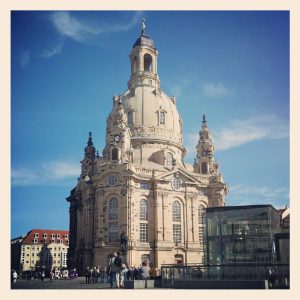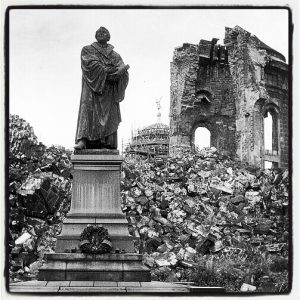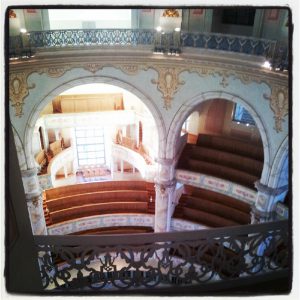Dresden’s Frauenkirche: Baroque splendor
By Tracy A. Burns
 On February 13, 1945, the bewitching, Baroque Protestant Frauenkirche was bombed in an air raid and reduced to ruins. The rubble would remain in the center of Dresden, the capital of the state of Saxony, for some 45 years. The church nicknamed the Stone Bell for its 96-meter high dome would not be consecrated again until 2005.
On February 13, 1945, the bewitching, Baroque Protestant Frauenkirche was bombed in an air raid and reduced to ruins. The rubble would remain in the center of Dresden, the capital of the state of Saxony, for some 45 years. The church nicknamed the Stone Bell for its 96-meter high dome would not be consecrated again until 2005.
Romanesque beginnings and Baroque glory
A Romanesque church hailing from the 11th century originally stood on the site of today’s Frauenkirche. Because it was too small for the congregation, the church was demolished in 1727. Built from 1726 to 1743, during the reigns of Electors of Saxony, Kings of Poland and Grand Dukes of Lithuania August III the Strong and his son August III of Poland, a German Reformation Baroque architectural gem took its place. Renowned city architect George Bahr designed it so that the altar, pulpit, and baptismal font were in the center, visible to the worshippers. Completed in 1738 after six years of work, the celebratory main altar recounted a scene of the tormented Christ on the Mount of Olives. An angel fluttered down from a cloud between golden beams.
Bach and Wagner
The extravagant organ, created by Gottfried Silbermann, was finished in 1736. That year Johann Sebastian Bach gave a concert in the church crowned with a huge, exquisitely painted dome that was supported by eight pillars. The Frauenkirche even inspired composer Richard Wagner to write “The Love Feast of the Apostles” and music for the opera “Parsifal.”
Surviving catastrophes
Tragedy struck the church during the Seven Years’ War (1756-1763), when Dresden capitulated to the Prussians. Johann Wolfgang von Goethe watched from its tower roof as cannonballs were flung at the church. Still, the church remained intact. Even when revolutionaries rioted in May of 1849, the Frauenkirche was not destroyed. The high tower dominated the Dresden cityscape for over 200 years. The place of worship in the city called “Florence on the Elbe” appeared to be indestructible.
Reduced to ruins
 Then came the air raid of February 13, 1945. Some 650,0000 bombs were dropped on the city which was reduced to ruins. The church held out for two days, collapsing on February 15. The 300 people who had gathered in the crypt for safety managed to get out before the church crumbled into 22,000 square meters of rubble. However, the remains of the two walls remained intact, and the altar was only damaged, not destroyed. The heads of the angels on the altar survived, though they were darkened by the fire. The bronze statue of Martin Luther, a key figure in the 16th century Reformation, was not smashed to bits, either. It stands in front of the church and hails from 1885.
Then came the air raid of February 13, 1945. Some 650,0000 bombs were dropped on the city which was reduced to ruins. The church held out for two days, collapsing on February 15. The 300 people who had gathered in the crypt for safety managed to get out before the church crumbled into 22,000 square meters of rubble. However, the remains of the two walls remained intact, and the altar was only damaged, not destroyed. The heads of the angels on the altar survived, though they were darkened by the fire. The bronze statue of Martin Luther, a key figure in the 16th century Reformation, was not smashed to bits, either. It stands in front of the church and hails from 1885.
After World War II
After the war the Soviets thwarted any plans to reconstruct the Frauenkirche, and it lay in ruins for some 45 years. A memorial promoting reconciliation and hope in the form of wild roses was located on the site. Nonviolent demonstrations against the East German regime took place amidst the rubble that once sparkled with Baroque splendor.
The reconstruction
After Communism collapsed in 1989, extensive fundraising and generous donations from Dresdner Bank financed the reconstruction that cost about 180 million euros. The rebuilding that began in 1993 was carried out with a fusion of original fragments of the church and advanced technology. Approximately 3,800 stones were saved from the rubble and used in the reconstruction. About 2,000 pieces of the original main altar are present in the restored relic, too. The builders had to rely on memories of former churchgoers and old photos plus construction drawings to make the church look as authentic as possible. The new golden cross and orb were made by Alan Smith, whose father had been one of the pilots that dropped bombs on the city in 1945. A replica of the 18th-century Silbermann organ was forged by Daniel Kern in 2005 and features 4,876 pipes.
The rebuilding from 1994 to 2005
The first stone was laid in May of 1994. The Frauenkirche opened its doors again in October of 2005. The remains of the original cross stand in the new church, reminding worshippers of both the tragedy and the long-awaited resurrection of the holy place. The exterior includes dark and light sandstone – the darker pieces are the originals tinged by the fire. The grave of George Bahr was also rebuilt.
The result of the restoration
 The result of the reconstruction efforts is astoundingly Baroque with a festive and lively flair. Take a look at some details. Peer closely at the rendition of Christ in agony on the main altar. The halo above the altar screams Baroque, and ornate pilasters are decorated with sunflowers under the cornice of the church. Fluted columns feature sheaves, corn, and grapes that symbolize the holy use of bread and wine. A delicate angel clad in seemingly fluttering, white drapery with a trombone decorates the organ. The four evangelists appear on the richly painted inner dome that is dynamic and vivacious. Check out the exquisite dormer windows and gables, too. The decorative painting in the galleries is also lively and cheerful. Yet there is also a certain sense of elegant simplicity to the grandeur.
The result of the reconstruction efforts is astoundingly Baroque with a festive and lively flair. Take a look at some details. Peer closely at the rendition of Christ in agony on the main altar. The halo above the altar screams Baroque, and ornate pilasters are decorated with sunflowers under the cornice of the church. Fluted columns feature sheaves, corn, and grapes that symbolize the holy use of bread and wine. A delicate angel clad in seemingly fluttering, white drapery with a trombone decorates the organ. The four evangelists appear on the richly painted inner dome that is dynamic and vivacious. Check out the exquisite dormer windows and gables, too. The decorative painting in the galleries is also lively and cheerful. Yet there is also a certain sense of elegant simplicity to the grandeur.
Admirers flock to the Frauenkirche
During the first three years after the completion of the new church, some 7 million people admired the church. In 2009 US President Barack Obama visited the Frauenkirche after a meeting with Chancellor of Germany Angela Merkel in the Green Vault of the Royal Palace.



